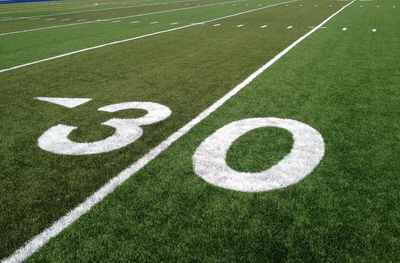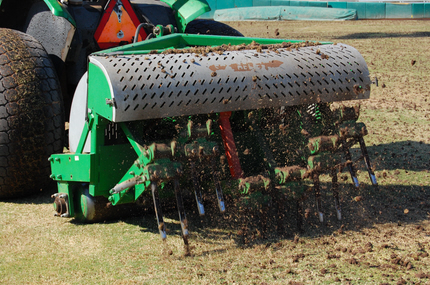Natural Grass vs Synthetic Turf Athletic Field Costs: Part 2
/This is part of a blog post series intended to be an accurate and unbiased discussion of sports field construction and maintenance costs for high performance natural grass athletic fields as compared to synthetic turf.
Natural Grass vs Synthetic Turf: A Comparison of Construction and Yearly Maintenance Costs
- Part 1 - Introduction and Overall Cost Comparison
- Part 2 - Construction Costs and Maintenance Methods
- Part 3 - Cost Comparison - New Field Install, Maintenance Labor and Materials
- Part 4 - Cost Comparison - Outsourced Work, Equipment Maintenance, Renovation and Resurfacing, Irrigation Water
- Part 5 - When is Synthetic Turf A Legitimate Option?
Construction Costs: Synthetic Turf (Infill Type) - $700K to $1.2M
How much does synthetic turf cost? Most of the newer synthetic turf installations consist of a compacted subgrade soil, internal drainage with poly liner followed by a rock aggregate layer, synthetic turf (in rolls) then a crumb rubber or sand mix groomed into the synthetic grass surface. Inlaid lines, numbers, hash marks and logos are typical to most installations now, as well.
Synthetic Turf Upgrade Options
- Cushion Pad. Placed between the grass and rock layer, this is an upgrade most manufacturers offer to provide a softer playing surface.
- Herringbone Internal Drainage. This system is an upgrade that catches internal water more efficiently and is deposited into the collector drains.
- Turf Model Upgrades. There are many grass upgrades to choose from. Coarse texture is less expensive than fine texture. Grass density upgrades are also available. Higher density means more expensive, requiring less infill.
- Infill Material. Options can vary from black crumb rubber to a silica sand and rubber mix. There are now lighter color synthetic infill options claiming to help reduce ground temperatures, which can be in excess of 140F degrees on a hot day.
- Irrigation Systems. Installed on the sidelines to help wash the field surface. Some sports facilities use water in an attempt to temporarily cool the surface, although many athletic training staffs try to avoid this, claiming it creates a worse environment with higher humidity for players trying to cool down in excessive temperatures.
- Colored End Zones and Logos. These can be installed in any variety of school colors. Also, goal posts can be reused or new ones can be installed along with the new field surface.
Other Factors Affecting Synthetic Turf Price
- Size of Existing Drainage Pipes and Catch Basins. Since an infill synthetic surface percolates rain water quickly, the exit drains need to be sufficiently large enough to handle the water volume. Substantial drainage improvements may be required based on a site's existing capabilities.
- Freight. Long hauls of rock material for base construction will be a huge budget item affecting the overall price.
- Preparation of the Existing Surface. Soil excavation and haul-off of spoils varies from field to field. There is usually a large amount of topsoil that can be stockpiled and used for other projects.
Construction Costs: Natural Grass (Sandy Soil) - $120K to $250K
Many sports field decision makers do not realize there is a more scientific way to build natural grass playing surfaces now than in the past. Soil science has come a long way in the past 20 years as well as improved grass cultivars. A typical high performance sports field installation consists of a medium compacted subgrade soil, commercial grade irrigation system, internal drainage system, six to eight inches of select sand-base root zone mix and hybrid bermudagrass (sprigged or sodded in big roll form).
Natural Grass Upgrade Options
- 4-Inch Gravel Layer.Installing this layer on top of the subgrade will dramatically improve the internal drainage capabilities of a field. If the gravel layer is used, then an 8 to 10-inch root zone would be needed.
- Root zone Amendments. Peat, calcined clay and fiber soil stabilizers can be used to improve the overall quality of the soil.
Other Factors Affecting Natural Grass Price
- Size of Existing Storm Drain System. Most high-quality natural grass fields can percolate anywhere between 3 and 10 inches of water per hour. The storm drain system must be sufficiently large enough to handle the water volume. Substantial drainage improvements may be required based on a site's existing capabilities.
- Freight. Large volumes of quality root zone mix will have to be imported so freight costs for materials will be a huge budget item affecting the overall price.
- Preparation of the Existing Surface. This typically includes killing the old grass, stripping the grass and soil, and the related haul-off cost of the removed materials.
- Irrigation Water Pressure / Volume. Low water pressure and water volume may need to be improved for a high performance irrigation system. In some instances a booster pump may be needed or a larger supply line may need to be installed.
Maintenance Methods - Synthetic Turf
Most schools we surveyed are performing minimal maintenance at the present time. These practices consist of sweeping, grooming the infill, trash and gum removal, repairing seams and occasionally washing soiled areas. A few schools are deep cleaning at least once per year usually followed by a disinfectant application.
At the college and professional level all of these maintenance practices are being performed at more regular intervals, even though field traffic is much lighter than the typical high school field.
Many school districts in Texas have found their synthetic surfaces start to show heavy wear patterns after the fourth and fifth years of service and need replacing after seven to eight years, even though they were told, and thus expected, the surfaces would last at least 10 years.
School districts and colleges that have had to prematurely replace their turf are looking for ways to make these surfaces last longer. Surveys concluded that deep cleaning, regularly scheduled grooming and cutting back on field traffic will make these surfaces last longer.
Deep cleaning is a process that removes some or most of the infill material, filters and removes dirt and debris, and lays the infill back into the turf while grooming the synthetic grass fibers so they stand up properly. This process decompacts the infill so that the "cushion" feel is back in the surface and straightens the grass fibers which helps prevent fiber breakdown. It's not unusual to deep clean once or twice per year for heavily used fields.
Sweeping and grooming are normally performed weekly during the time of year when a field is most heavily used and less frequently during the slower periods. Trash pick up, removing gum, animal feces removal and sanitation are usually performed several times per week.
Seam maintenance is performed as soon as a problem is noticed by the maintenance staff responsible for the field.
Washing the field down with a sideline irrigation system (if available) would be preferred, as needed, during dry weather periods.
Maintenance Methods - Natural Grass
High performance natural grass sports fields require regularly scheduled maintenance practices. These practices include mowing, aerification, fertilization, pest and weed control, and irrigation system maintenance. Painting boundary lines and logos are in-season chores normally performed by maintenance personnel.
During the growing season it is normal to mow every other day (Mon/Wed/Fri). In early spring and late fall, mowing every third day (Mon/Thurs) is normal.
Aerification frequency can vary according to field use, but to keep the field in pristine shape aerating four to six times per year would be normal.
Deep tine aerification and topdressing once per year during the off-season is normal for high-use fields.
Fertilizer applications every four to six weeks during the growing season along with seasonal insect and weed control measures are necessary to keep natural grass sports fields performing at a high level.
Painting field lines are performed weekly in-season as well as logos for home varsity games.
Irrigation system maintenance check-ups should be performed about every three months.



